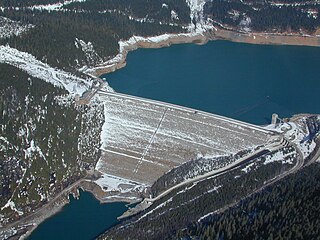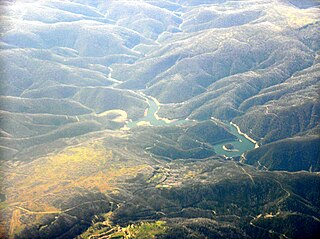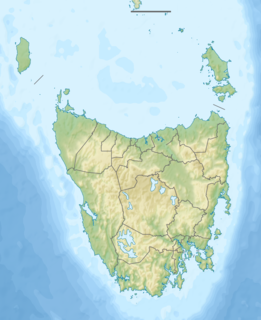
Mica Dam, a hydroelectric dam spanning the Columbia River 135 kilometres north of Revelstoke, British Columbia, Canada, was built as one of three Canadian projects under the terms of the 1964 Columbia River Treaty and is operated by BC Hydro. Completed in 1973 under the terms of the treaty, the Mica powerhouse had an original generating capacity of 1,805 megawatts (MW). Mica Dam, named after the nearby settlement of Mica Creek and its associated stream, in turn named after the abundance of mica minerals in the area, is one of the largest earthfill dams in the world. The reservoir for the dam is Kinbasket Lake, which was created when the dam was built. Water from the dam flows south directly into Revelstoke Lake, the reservoir for the Revelstoke Dam. Mica Dam is the tallest dam in Canada and second tallest in North America after the Chicoasén Dam in Mexico and it is the farthest upstream dam on the Columbia River. The dam's underground powerhouse was the second largest in the world at the time of its construction, and was the first 500 kV installation of sulphur hexafluoride (SF6) insulated switchgear in the world.

Hugh Keenleyside Dam is a flood control dam spanning the Columbia River, 12 km upstream of the city of Castlegar, British Columbia, Canada.

Loch Rannoch is a freshwater loch in Perth and Kinross, Scotland. It is over 15 kilometres (9.3 mi) long in a west–east direction with an average width of about 1.2 kilometres (0.75 mi), and is deepest at its eastern end, reaching a depth of 130 metres (440 ft). The River Tummel begins at its eastern end, where the small village of Kinloch Rannoch can be found, whilst the wild expanse of Rannoch Moor extends to the west of the loch. The area surrounding Loch Rannoch, along with Rannoch Moor itself, was formerly part of the native Caledonian Forest that stretched across much of Northern Scotland. Native forest is now largely absent from much of the area, due partly to logging, and partly to the climate becoming wetter, and Loch Rannoch is now largely surrounded by commercial forestry and open hillsides, although a small area remains at the Black Wood of Rannoch on the southern shore of the loch.

Longannet power station was a large coal-fired power station in Fife, and the last coal-fired power station in Scotland. It was capable of co-firing biomass, natural gas and sludge. The station stands on the north bank of the Firth of Forth, near Kincardine on Forth.

Longtan Dam is a large roller-compacted concrete (RCC) gravity dam on the Hongshui River in Tian'e County of the Guangxi Zhuang Autonomous Region, China, a tributary of the Xi River and the Pearl River. The dam is 216.2 metres (709.3 ft) high and 849 m (2,785 ft) long; it is the tallest of its type in the world. The dam is intended for hydroelectric power production, flood control and navigation. The dam contains seven surface spillways, two bottom outlets and an underground power station. The Longtan ship lift, part of the dam complex, will be the tallest ship lift system in the world.

Tumut Hydroelectric Power Station is a series of three of the original four, now five hydroelectric power stations on the Tumut River in New South Wales, Australia, that are part of the Snowy Mountains Scheme.

The Rowallan Power Station is a conventional hydroelectric power station located in north-western Tasmania, Australia. The station is located 25 kilometres (16 mi) south of Liena.

Tumut Pond Dam is a major ungated concrete arch dam across the upper reaches of the Tumut River in the Snowy Mountains of New South Wales, Australia. The dam's main purpose is for the generation of hydro-power and is one of the sixteen major dams that comprise the Snowy Mountains Scheme, a vast hydroelectricity and irrigation complex constructed in south-east Australia between 1949 and 1974 and now run by Snowy Hydro.

The Splityard Creek Dam is a rock and earth-fill embankment dam with an un-gated spillway across the Pryde Creek that is located in the South East region of Queensland, Australia. The sole purpose of the dam is for the generation of hydroelectricity. The impounded reservoir is called the Splityard Creek Reservoir.

The Bakhtiari Dam is an arch dam currently under construction on the Bakhtiari River within the Zagros Mountains on the border of Lorestan and Khuzestan Provinces, Iran. At a planned height of 325 metres (1,066 ft), it will be the world's tallest dam once completed and withhold the second largest reservoir in Iran after the Karkheh reservoir. The main purpose of the dam is hydroelectric power production and it will support a 1,500 MW power station. By trapping sediment, the dam is also expected to extend the life of the Dez Dam 50 km (31 mi) downstream.

The Siah Bisheh Pumped Storage Power Plant, also spelled Siyāhbisheh and Siah Bishe, is located in the Alborz Mountain range near the village of Siah Bisheh and 48 km (30 mi) south of Chalus in Mazandaran Province, Iran. The power plant uses the pumped-storage hydroelectric method to generate electricity during periods of high energy demand, making it a peaking power plant, intended to fulfill peak electricity demand in Tehran 60 km (37 mi) to the south. When complete it will have an installed generating capacity of 1,040 megawatts (1,390,000 hp) and a pumping capacity of 940 megawatts (1,260,000 hp). Planning for the project began in the 1970s and construction began in 1985. It was delayed from 1992 until 2001 and the first generator went online in May 2013. The remaining generators were commissioned by 1 September 2015. The power plant is the first pumped-storage type in Iran and will also use the country's first concrete-face rock-fill dam – two of them.

The Cruachan Power Station is a pumped-storage hydroelectric power station in Argyll and Bute, Scotland. The scheme can provide 440 MW of power and has a capacity of 7.1 GWh.

The Shuangjiangkou Dam, also referred to as Shuang Jiang Kou, is an embankment dam currently being constructed on the Dadu River in Sichuan Province, China. When completed, the 312-metre-tall (1,024 ft) dam will be the tallest dam in the world. Preliminary construction began in 2008 and the entire project was expected to be complete in 2018. By April 2011, over 200,000,000 m3 (261,590,124 cu yd) of material had been excavated from the construction site. In March 2013, China's Ministry of Environmental Protection approved construction on the dam's superstructure and associated facilities. The government acknowledged that the dam would have negative impacts on the environment but that developers were working to mitigate them. The dam is being built by the Guodian Group at a cost of US$4.02 billion. The entire construction period is expected to last 10 years. All turbines are expected to be commissioned by 2023.

La Esmeralda Dam is an embankment dam on the Batá River northwest of Santa María in Boyacá Department, Neira Province, Valle de Tenza Colombia, 52 km to south of Tunja city. The primary purpose of the dam is hydroelectric power production and it is part of the Chivor Hydroelectric Project. Water from the Batá is diverted by the dam to a power station that discharges to the Lengupá River. The power station supplies 8% of Colombia's power demand.

The Pandoh Dam is an embankment dam on the Beas River in Mandi district of Himachal Pradesh, India. Under the Beas Project, the dam was completed in 1977 and its primary purpose is hydroelectric power generation. Part of a run-of-the-river power scheme, it diverts the waters of the Beas to the southwest through a 38 km (24 mi) long system of tunnels and channels. The water is used for power generation at the Dehar Power House before being discharged into the Sutlej River, connecting both rivers. The power house has an installed capacity of 990 MW. The system diverts 256 cumecs of Beas waters to the Satluj River. The project was completed in 1977.

The Cobb Reservoir, surrounded by Kahurangi National Park and fed by the Cobb River, is in the South Island of New Zealand. The reservoir feeds the Cobb Power Station and is 819 metres (2,687 ft) above sea level but drops significantly with low rainfall. Cobb Reservoir is the highest hydro storage lake in New Zealand.

Tumut Two Dam or Tumut Two is a major ungated concrete gravity dam across the upper reaches of the Tumut River in the Snowy Mountains of New South Wales, Australia. The dam's main purpose is for the generation of hydro-power and is one of the sixteen major dams that comprise the Snowy Mountains Scheme, a vast hydroelectricity and irrigation complex constructed in south-east Australia between 1949 and 1974 and now run by Snowy Hydro.

Bendeela Pondage, completed in 1972, is an earth and rockfill embankment dam structure located on the Kangaroo River arm of Lake Yarrunga in New South Wales, Australia. It is located between Fitzroy Falls Dam and Tallowa Dam. The pondage, part of the Shoalhaven Scheme, functions as a buffer storage for out-of-balance flow between the two dams during hydro-electric power generation or water pumping at Kangaroo Valley and Bendeela pumping and power stations. The dam has no significant catchment but has been provided with a weir type spillway to protect the dam in the event of operational problems at the two pumping and power stations. The embankment is 15 metres (49 ft) high and 2,118 metres (6,949 ft) in length. At 100% capacity, the dam wall holds back approximately 1,200 megalitres.

The Hart-Jaune Dam (French: Barrage de la Hart-Jaune is a dam in Quebec, Canada. It crosses the Hart Jaune River where it leaves the Petit lac Manicouagan. It regulates the flow of water to the 45.5 MW Hart-Jaune generating station.



















